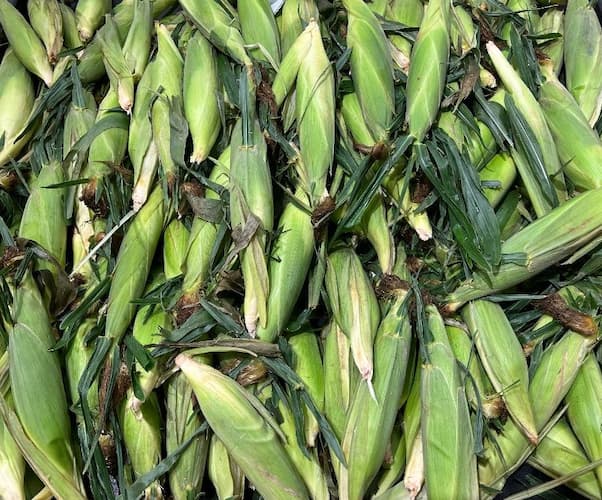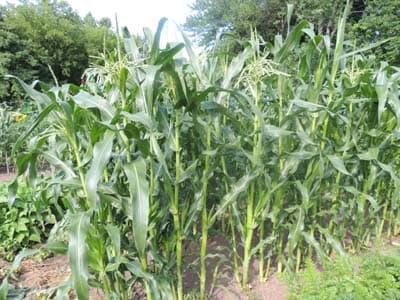How to Grow Sweet Corn

Grow Sweet Corn in Your Garden
Unless you’re space constrained, you’ve just gotta grow sweet corn in your garden. Sweet Corn is one of the most popular vegetables. People look forward all year to fresh corn on the cob in late summer. Very little compares to the fresh taste of corn picked from the garden, moments before it is cooked. Corn loses its flavor very rapidly. Once it is picked, the sugars immediately begin to turn to starch.
The only trouble with growing sweet corn is it requires a large amount of space to grow. Most backyard gardeners grow tomatoes because they can grow as few as one plant. And, that one plant takes up very little space. Even urban backyard gardeners have enough space for a single tomato plant. Planting corn requires a minimum of three rows (ideally four), of about four feet in length. The space between rows needs to be three feet. This minimum space allows adequate pollination for the ears. Corn is pollinated by pollen from its tassels (the tops of the plant). Compare this to tomatoes, which are self-pollinating (which is why you can grow a single plant).
Corn usually produces one to two ears per plant. Also, the stalks are popular for fall decorations where They can be used in a variety of outdoor displays. As a result, you get two uses out of your crop. If you are a farmer, there is a third use, too. Livestock can be fed the stalks after the fall decorations are through.
Did You Know? The Greek Goddess of Corn is Demeter. She oversees grains and the fertility of the earth.
Varieties of Sweet Corn
Yellow– The most common and popular of varieties. There is a wide range of types of seed within this category.
White – With white kernels, this author and many others consider white corn to be among the best-tasting corn you can find. Among this category, Silver Queen corn is the most popular by far.
Bi-Color– This variety boasts both yellow and white kernels. Not only does it taste good, but it also looks good too!
Popcorn– Kids and adults will enjoy the thrill of growing their own popcorn and popping it in the fall. Importantly, the ears need to thoroughly dry. Rub two dry ears together to remove the kernels from the cob, or take the cob with kernels still attached, and pop it in the microwave! How to Grow and Dry Popcorn
Broom Corn– Few people today are familiar with Broom corn. This corn was grown for the thin, strong stalks. First, they are dried. Then, they are tied at the end of a stick to make a broom.
Ornamental Indian Corn– This is grown only for decorative purposes. It is dried and the ears are used as decoration for Halloween, Thanksgiving, and other fall events. Common, popular varieties include Ornamental multi-color Indian Corn and, Blue Hopi.
Tall stalks– This corn is grown for its tall stalk. It is used in competition at fall festivals. A stalk from this variety can grow over twenty feet!

How to Grow Sweet Corn
Grow corn in full sun and rich garden soil.
Plant seeds in rows, about 1/2 to 1 inch deep. Space seeds four to six inches apart, in rows three feet apart. Some home gardeners plant two seeds close together then, thin out one of them if both grow. This assures maximum use of limited garden space, with no gaps due to poor germination. Another method is to space the seed closer together, then thin them. Water well after planting, and again two to four days later if there has been no rain.
Seeds will sprout in about 10-14 days.
To assure proper pollination, plant four rows four feet long.
Tip: Some gardeners try to transplant corn seedlings to fill gaps in the row. In general, corn does not transplant well. You can succeed, however, under the right conditions. First, transplant when the seedling is very small. Second, transplant in cooler weather and near evening. Dig extra deep, to extract as much of the plant’s roots as possible. Seedlings send out a long, deep taproot. Finally, water well and daily for about a week.
As the plant grows, it can be susceptible to high winds. Pile up garden soil around the base of the plants, to help prevent damage.
Fertilize with a general-purpose fertilizer every two to three weeks.
Water regularly in dry weather. Water deeply.
Keep plants well weeded in their early life. Place mulch between the rows to keep weeds down.
Soil Ph: 5.5 – 7.5 Ideal Soil pH for vegetables
Also, see:
Soil Temperatures – Ideal germination temperature by vegetable
Insects and Pests
Corn Earworms and silkworms are the most common pests. Insects are not often a problem until the ears begin to form. Entry is through the silk. Sevin dust is very effective when applied directly on the silk, or dusted in the air.
To control corn earworms, some people apply a couple of drops of mineral oil to the silk. Apply it after pollination. The mineral oil suffocates the earworms.
Deer are also a problem if they exist in your area.
Occasionally,birds will enjoy a meal on your corn. Blue jays are common feeders in cornfields. Try putting up a scarecrow to keep them away. Scarecrows have been in use for thousands of years. All about scarecrows.
Plant Disease
Until the ear begins to form, corn usually experiences few disease problems. Occasionally a fungus develops at the ear. It is a black-ish, purple-colored glob. It grows in rainy weather. If corn fungus is present, remove and destroy the plant. Put it in the garbage and not in your compost pile where the fungus can harbor and be transferred to other crops.
Did you Know? That ugly, black-ish, purplish fungus on your corn stalk is edible. It is considered a delicacy to some. In Mexico, it is called “cuitlacoche”.
Plant Problems – Diagnosis, causes, and cures for many common plant problems.
How to Grow Sweet Corn - Harvest Time
Corn is at its best when the kernels have just filled out. It is best to pick the ears just before eating them. If you need to store it, harvest ears in the morning when it is at its peak sweetness. Do not shuck the ears, until ready to cook.
Corn is ready when the silk has dried and turned a dark brown.
If you are inexperienced at picking corn in the field, select an ear that looks ripe. Without taking it off the plant, pull the husk back, just enough to expose the tip of the ear. If it is not ripe, close it back up and tie a “twist tie” around it to seal out the bugs.
Pull ears down, while twisting, to break them off the plant.
It helps to hold the cornstalk with your free hand. This avoids breaking the stalk of the plant.
On the Grill: On those hot summer days when it is too hot to boil water indoors, try grilling corn. Just soak the ears, husk, and all, in a bucket of water for a couple of hours. Then, cook it on your grill, turning regularly. When it’s done, pull off the husk, eat and enjoy! Corn on the Cob, Grilled
Plant Hardiness
The plants like it hot. It is somewhat resistant to dry weather. The roots go deep, seeking moisture in dry summer conditions. It will be one of the last garden vegetables to wilt in the heat of the sun and drought conditions. The plants do not like frost or freezes. Although they may survive light or scattered frosts.
Thought for the Day: If Jimmy cracks corn, and no one cares, why is there a song about him!?
Corn Recipes
Related Articles
Growing Sweet Corn – more information from Garden Hobbies.
Please support our site. Shop for:
- rmmatthews100@hotmail.com
- 585-721-6528
- Rochester, NY
©1999-2024 GardenersNet.Com, All Rights Reserved

